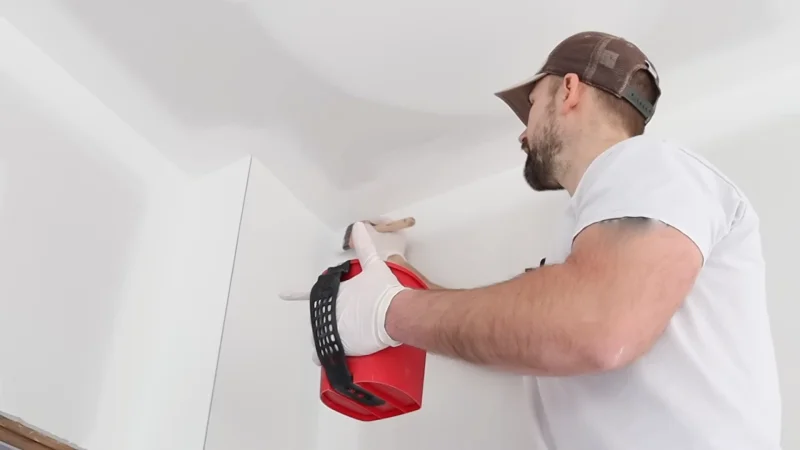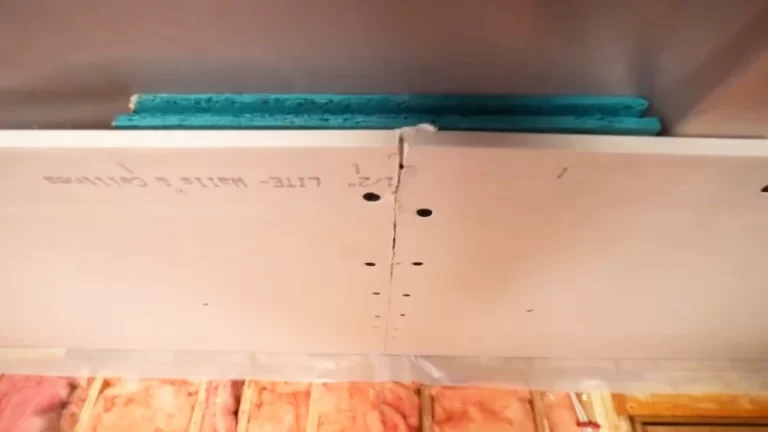Why Joint Compound Liquid on the Top?

Joint compound is an essential material in the construction and repair of drywall surfaces. It is used to fill in gaps, seams, and imperfections in the drywall, creating a smooth and seamless finish. Joint compound comes in several different forms, including ready-mix, which is a pre-mixed version that can be easily applied with a putty knife or taping tool.
However, sometimes joint compound can develop a liquid layer on top, which is often referred to as “whey.” This liquid may form if the joint compound has been stored improperly or left open for an extended period of time.
While the presence of this liquid may be a cause for concern, it does not necessarily mean that the joint compound is no longer usable. In many cases, the liquid can be mixed back into the compound and applied as normal.
You'll Learn About
What is Joint Compound Liquid on Top?
Joint compound liquid on top, also known as “whey,” is a liquid layer that can form on top of joint compound when it is improperly stored or left open for an extended period of time. This liquid is typically composed of water and other additives that are used to improve the workability and spreadability of the compound.
It is generally clear or yellowish in color and has a thin, watery consistency. The presence of this liquid may be a cause for concern for those using joint compound, as it may indicate that the compound is no longer usable.
However, in many cases, the liquid can be mixed back into the compound, allowing it to be used as normal. It is important to properly store joint compound to prevent the formation of this liquid layer, and to mix the compound thoroughly before applying it to the drywall.
Why Joint Compound Liquid on the Top?
Joint compound is a material that is used in the construction and repair of drywall surfaces. It is applied to fill in gaps, seams, and imperfections in the drywall, and is typically used in conjunction with drywall tape to create a seamless finish. Joint compound comes in several different forms, including ready-mix, which is a pre-mixed version that can be easily applied with a putty knife or taping tool.
One thing to be aware of when using joint compound is that it can sometimes separate into a solid body and a liquid on top. This can occur if the joint compound has been stored improperly, or if it has been left open for an extended period of time. The liquid that forms on top of the joint compound is often referred to as “whey,” and it is typically composed of water and other additives that help to improve the workability and spreadability of the compound.
While the presence of liquid on top of joint compound may be a cause for concern, it does not necessarily mean that the compound is no longer usable. In many cases, the liquid can be mixed back into the compound by stirring it with a putty knife or other tool, or by using a drill and mixing paddle to blend it together. If the joint compound is still usable, it can be applied to the drywall as normal, following the manufacturer’s instructions and allowing it to dry according to the recommended time frame.
Is Joint Compound With Liquid on Top Still Usable?
Whether or not joint compound with liquid on top is still usable depends on the specific circumstances and the condition of the compound. In many cases, the liquid can be mixed back into the compound, allowing it to be used as normal.
To mix the liquid back into the compound, you can use a putty knife or other tool to stir it in, or you can use a drill and mixing paddle to blend it together. It is important to mix the compound thoroughly to ensure that it is evenly distributed and that the liquid is fully incorporated into the body of the compound.
If the joint compound has been left open for an extended period of time or has been exposed to extreme temperatures, it may have hardened or become otherwise compromised, making it no longer usable. In these cases, it is best to discard the compound and replace it with a new batch. It is also a good idea to check the expiration date of the compound, as it may have expired and lost its effectiveness.
Overall, it is important to properly store joint compound and to mix it thoroughly before applying it to the drywall to ensure that it is in good condition and ready for use. If you do encounter joint compound with liquid on top, it is worth trying to mix it back in to see if it is still usable, but be prepared to replace it if necessary.
How to Apply Joint Compound With Liquid on Top
To apply joint compound with liquid on top to your drywall, you will first need to properly mix the compound to ensure that it is evenly distributed and ready for use. Here are the steps for mixing and applying joint compound with liquid on top:
Stirring the Joint Compound
Begin by stirring the joint compound to mix the liquid back into the body of the compound. You can use a putty knife or other tool to do this, or you can use a drill and mixing paddle if you have one. Mix the compound thoroughly, making sure that the liquid is fully incorporated and that the compound has a smooth and uniform consistency.
Applying It to the Drywall
Once the compound is properly mixed, you can begin applying it to the drywall. Use a putty knife or taping tool to spread the compound evenly over the area that you are working on. Be sure to follow the manufacturer’s instructions for application, as different types of joint compound may have different recommended application techniques.
Spread It as Smoothly
As you apply the joint compound, try to spread it as smoothly and evenly as possible. Use the edge of the putty knife or taping tool to smooth out any bumps or irregularities, and try to avoid applying too much pressure, as this can create divots or other imperfections in the surface.
Allow to Dry
Allow the joint compound to dry according to the manufacturer’s instructions, which may vary depending on the specific product and the ambient temperature and humidity. Once the compound is dry, you can sand it lightly with fine-grit sandpaper to create an even and smooth finish.
Overall, the key to applying joint compound with liquid on top is to mix it thoroughly and follow the manufacturer’s instructions for application. By properly preparing the compound and applying it evenly, you can achieve a smooth and seamless finish on your drywall.
Tips for Using Joint Compound on Top
Here are some additional tips for using joint compound:
- Always follow the manufacturer’s instructions for mixing, applying, and drying times. Different brands and types of joint compound may have different recommendations, so it is important to follow the specific guidelines for the product you are using.
- Use a putty knife or taping tool to apply the joint compound. These tools are specifically designed for working with joint compound and can help you achieve a smooth and even finish.
- If you are working on a large area or multiple sections of drywall, consider using a hawk and trowel to apply the joint compound. This can help you cover a larger area more efficiently and can also help you achieve a smoother finish.
- When applying joint compound, use a light touch and avoid applying too much pressure. This can help prevent divots or other imperfections in the surface.
- To avoid air bubbles in your joint compound, be sure to smooth it out as much as possible as you apply it. You can also use a roller or other tool to gently press down on the compound to remove any air bubbles that may have formed.
- If you are working with multiple layers of joint compound, be sure to allow each layer to dry completely before applying the next one. This will help ensure that the compound adheres properly and that the final finish is smooth and even.
- When sanding the joint compound, use a fine-grit sandpaper to avoid damaging the drywall surface. Sand the compound gently, using long, sweeping strokes to avoid creating any dips or unevenness in the surface.
To Recap
Joint compound is an essential material in the construction and repair of drywall surfaces. It is used to fill in gaps, seams, and imperfections, creating a smooth and seamless finish. While the presence of liquid on top of joint compound may be a cause for concern, it does not necessarily mean that the compound is no longer usable.
In many cases, the liquid can be mixed back into the compound and applied as normal, as long as it is properly mixed and applied according to the manufacturer’s instructions. It is important to properly store joint compound to prevent the formation of this liquid layer, and to mix the compound thoroughly before applying it to the drywall to ensure that it is in good condition and ready for use.
By following these guidelines, you can successfully use joint compound with liquid on top to achieve a professional-quality finish on your drywall projects.

